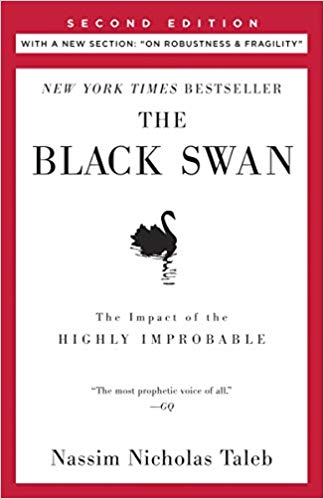

This article is an excerpt from the Shortform summary of "The Black Swan" by Nassim Taleb. Shortform has the world's best summaries of books you should be reading.
Like this article? Sign up for a free trial here .
No one can predict the future. But why? Why are some situations and events more predictable than others?
We’ll cover the nature of predictability according to Nassim Nicholas Taleb and look at why it is that no one can predict the future.
No One Can Predict the Future: Why Not?
Taleb, however, offers a new spin on the term “black swan”. He uses it to describe specific historical events with specific impacts. These events have three salient features:
- They are “outliers” (that is, they are statistically insignificant);
- They have profound real-world impacts; and
- Despite (or perhaps because of) their extreme unpredictability, they compel human beings to account for them—to explain after the fact that they were in fact predictable.
Some examples of Black Swan events include World Wars I and II, the fall of the Berlin Wall, 9/11, the rise of the Internet, the stock-market crash of 1987, and the 2008 financial crisis. Black swans are one of the reasons that no one can predict the future.
Taleb’s thesis is that Black Swans, far from being insignificant or unworthy of systematic study, comprise the most significant phenomena in human history. We should study them, even if we can’t predict them. Thus, counter-intuitively, we would be better served by concentrating our intellectual energies on what we don’t—nay, can’t—know, rather than on what we do and can know.
Taleb also claims, also counter-intuitively, that the more our knowledge advances, the more likely we are to be blindsided by a Black Swan. This is because our knowledge is forever becoming more precise and specific and less capable of recognizing generality—for example, the general tendency for earth-shattering events to be completely unforeseen (which, of course, is why they’re earth-shattering).
The Unreliability of “Experts”
Even though no one can predict the future, many people try to. Taleb has very little patience for “experts”—academics, thought leaders, corporate executives, politicians, and the like. Throughout the book, Taleb illustrates how and why “experts” are almost always wrong and have little more ability to predict the future than the average person.
There are two reasons “experts” make bad predictions and no one can predict the future:
1) Human Nature
Because of various habits innate to our species—our penchant for telling stories, our belief in cause and effect, our tendency to “cluster” around specific ideas (confirmation bias) and “tunnel” into specific disciplines or methods (specialization)—we tend to miss or minimize randomness’s effect on our lives. Experts are no less guilty of this blindspot than your average person. This is one reason no one can predict the future.
2) Flawed Methods
Because experts both (1) “tunnel” into the norms of their particular discipline and (2) base their predictive models exclusively on past events, their predictions are inevitably susceptible to the extremely random and unforeseen.
Consider, for example, a financial analyst predicting the price of a barrel of oil in ten years. This analyst may build a model using the gold standards of her field: past and current oil prices, car manufacturers’ projections, projected oil-field yields, and a host of other factors, computed using the techniques of regression analysis. The problem is that this model is innately narrow. It can’t account for the truly random—a natural disaster that disrupts a key producer, or a war that increases demand exponentially.
Taleb draws a key distinction between experts in Extremistan disciplines (economics, finance, politics, history) and Mediocristan disciplines (medicine, physical sciences). Experts like biologists and astrophysicists are able to predict events with fair accuracy; experts like economists and financial planners are not.
Difficulties of Prediction
The central problem with experts is their uncritical belief in the possibility of prediction, despite the mountain of evidence that indicates prediction is a fool’s errand and that no one can predict the future. Some key illustrations of the futility of prediction include:
Discoveries
Most groundbreaking discoveries occur by happenstance—luck—rather than careful and painstaking work. The quintessential example is the discovery of penicillin. Discoverer Alexander Fleming wasn’t researching antibiotics; rather, he was studying the properties of a particular bacterium. He left a stack of cultures lying out in his laboratory while he went on vacation, and when he returned he found that a bacteria-killing mold had formed on one of the cultures. Voilá—the world’s first antibiotic.
Dynamical Systems
A dynamical system is one in which an array of inputs affect each other. Whereas prediction in a system that contains, say, two inputs, is a simple affair—one need only account for the qualities and behavior of those two inputs—prediction in a system that contains, say, five hundred billion inputs is effectively impossible. Because we live in a dynamical system, no one can predict the future.
The most famous illustration of a dynamical system’s properties is the “butterfly effect.” This idea was proposed by an MIT meteorologist, who discovered that an infinitesimal change in input parameters can drastically change weather models. The “butterfly effect” describes the possibility that the flutter of a butterfly’s wings can, a few weeks later and many miles distant, cause a tornado.
Predicting the Past
The past itself is as unknowable as the future. Because of how complex the world is and how a single event could be influenced by any number of tiny causes, we cannot reverse engineer causes for events.
An example should help illustrate. Think of an ice cube sitting on a table. Imagine the shape of the puddle that ice cube will make as it melts.
Now think of a puddle on the table and try to imagine how that puddle got there.
When historians propose causes for certain historical events, they’re looking at puddles and imagining ice cubes (or a spilled glass of water, or some other cause). The problem is that the sheer number of possible causes for a puddle—or a historical event—render any ascription of cause suspect.
If You Can’t Predict the Future, How Do You Deal with Uncertainty?
Although Taleb is far more concerned with explaining why no one can predict the future than he is with proposing alternatives or solutions, he does offer some strategies for dealing with radical uncertainty.
1) Don’t Sweat the Small Predictions
When it comes to low-stakes, everyday predictions—about the weather, say, or the outcome of a baseball game—there’s no harm in indulging our natural penchant for prediction: If we’re wrong, the repercussions are minimal. It’s when we make large-scale predictions and incur real risk on their basis that we get into trouble.
2) Maximize Possibilities for Positive Black Swans
Although the most memorable Black Swans are typically the negatively disruptive ones, Black Swans can also be serendipitous. (Shortform note: Love at first sight is an example of a serendipitous Black Swan.)
Two strategies for opening ourselves up to positive Black Swans are (1) sociability and (2) proactiveness when presented with an opportunity. Sociability puts us in the company of others who may be in a position to help us—we never know where a casual conversation might lead. And proactiveness—for example, taking up a successful acquaintance on an invitation to have coffee—ensures we’ll never miss our lucky break. Just because no one can predict the future doesn’t mean you can’t be ready to take advantage of lucky opportunities.
3) Adopt the “Barbell Strategy”
When Taleb was a trader, he pursued an idiosyncratic investment strategy to inoculate himself against a financial Black Swan. He devoted 85%–90% of his portfolio to extremely safe instruments (Treasury bills, for example) and made extremely risky bets—in venture-capital portfolios, for example—with the remaining 10%–15%. (Another variation on the strategy is to have a highly speculative portfolio but to insure yourself against losses greater than 15%.) The high-risk portion of Taleb’s portfolio was highly diversified: He wanted to place as many small bets as possible to increase the odds of a Black Swan paying off in his favor.
The “barbell strategy” is designed to minimize the pain of a negative Black Swan while, potentially, reaping a positive Black Swan’s benefits. If the market collapses, a person pursuing this strategy isn’t hurt beneath the “floor” of the safe investments (say, 85%), but if the market explodes, he has a chance to capitalize by virtue of the speculative bets.
4) Distinguish Between Positive Contingencies and Negative Ones
Different areas of society have different exposure to Black Swans, both positive and negative. For example, scientific research and moviemaking are “positive Black Swan areas”—catastrophes are rare, and there is always the possibility of smashing success. The stock market or catastrophe insurance, meanwhile, are “negative Black Swan areas”—upsides are relatively modest compared to the possibility of financial ruin.
Suffice it to say, we should take more risks in a positive Black Swan area than in a negative Black Swan one. Even if no one can predict the future, everyone should know where it makes sense to take the most risk.
5) Prepare, Don’t Predict
No one can predict the future! Because Black Swans are, by definition, unpredictable, we’re better off preparing for the widest range of contingencies than predicting specific events.
That’s because, though Black Swans themselves can never be predicted, their effects can be. For example, no one can predict when an earthquake will strike, but one can know what its effects will be and prepare adequately to handle them.
The same goes for an economic recession. No one can predict precisely when one will occur, but, using the “barbell strategy” or some other means of mitigating risk, we can at least be prepared for one.
———End of Preview———

Like what you just read? Read the rest of the world's best summary of "Black Swan" at Shortform . Learn the book's critical concepts in 20 minutes or less .
Here's what you'll find in our full Black Swan summary :
- Why world-changing events are unpredictable, and how to deal with them
- Why you can't trust experts, especially the confident ones
- The best investment strategy to take advantage of black swants






